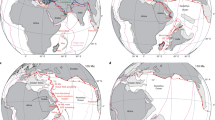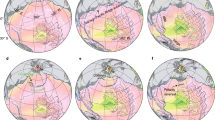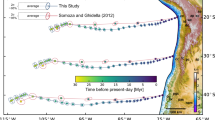Abstract
Global reorganizations of tectonic plates may be caused by a trigger such as a continental collision or a rising mantle plume. However, whether and how such a trigger propagates through a plate circuit remains unclear. Here we use a plate kinematic model to quantify relative motions between the African and Eurasian plates following a plume-induced plate motion change that triggered formation of a new subduction zone within the Neotethys Ocean at 105 Ma. We constrain the plate kinematic model by geomagnetic intensity variations recorded in Atlantic quiet zone crust that formed during the Cretaceous Normal Superchron (126–83 Ma), during which magnetic reversals were absent. We find that convergence rate changes between Africa and Eurasia are well explained by the initiation and arrest of the plume-induced subduction zone. Our plate kinematic model also reveals that the plate acceleration that followed upon subduction initiation changed the Africa–Eurasia convergence direction, which in turn was accommodated by subsequent subduction initiation about 85 Ma in the Alpine region that then triggered a cascade of regional tectonic events. This plate tectonic chain reaction illustrates how changes in plate motion, underpinned by mantle dynamics, may self-perpetuate through a plate circuit.
This is a preview of subscription content, access via your institution
Access options
Access Nature and 54 other Nature Portfolio journals
Get Nature+, our best-value online-access subscription
$29.99 / 30 days
cancel any time
Subscribe to this journal
Receive 12 print issues and online access
$259.00 per year
only $21.58 per issue
Buy this article
- Purchase on Springer Link
- Instant access to full article PDF
Prices may be subject to local taxes which are calculated during checkout




Similar content being viewed by others
Data availability
Rotation and shape files for plate kinematic model made in GPlates reconstruction software53 were provided as supplementary information to previous papers22,26,49,65. GPlates files with reconstructions used to draft Figs. 1 and 4 are provided at https://figshare.com/articles/dataset/van_Hinsbergen_NatureGeo_2021_GPlates_zip/13516727. Marine magnetic data can be obtained at the NCEI GEODAS database: https://www.ngdc.noaa.gov/mgg/geodas/trackline.html.
Code availability
GPlates plate reconstruction software53 used for developing our plate kinematic model is available from https://www.gplates.org/.
References
Torsvik, T. H., Müller, R. D., Van der Voo, R., Steinberger, B. & Gaina, C. Global plate motion frames: toward a unified model. Rev. Geophys. 46, RG3004 (2008).
Matthews, K. J., Seton, M. & Müller, R. D. A global-scale plate reorganization event at 105−100 Ma. Earth Planet. Sci. Lett. 355–356, 283–298 (2012).
Müller, R. D. et al. Ocean basin evolution and global-scale plate reorganization events since Pangea breakup. Annu. Rev. Earth Planet. Sci. 44, 107–138 (2016).
Olierook, H. K. H. et al. Timing and causes of the mid-Cretaceous global plate reorganization event. Earth Planet. Sci. Lett. 534, 116071 (2020).
Rona, P. A. & Richardson, E. S. Early Cenozoic global plate reorganization. Earth Planet. Sci. Lett. 40, 1–11 (1978).
O’Connor, J. M. et al. Constraints on past plate and mantle motion from new ages for the Hawaiian–Emperor Seamount chain. Geochem. Geophys. Geosyst. 14, 4564–4584 (2013).
Seton, M. et al. Ridge subduction sparked reorganization of the Pacific plate–mantle system 60–50 million years ago: Pacific plate–mantle reorganization. Geophys. Res. Lett. 42, 1732–1740 (2015).
Whittaker, J. M. et al. Major Australian–Antarctic plate reorganization at Hawaiian–Emperor bend time. Science 318, 83–86 (2007).
Cande, S. C. & Stegman, D. R. Indian and African plate motions driven by the push force of the Reunion plume head. Nature 475, 47–52 (2011).
van Hinsbergen, D. J., Steinberger, B., Doubrovine, P. V. & Gassmöller, R. Acceleration and deceleration of India–Asia convergence since the Cretaceous: roles of mantle plumes and continental collision. J. Geophys. Res. Solid Earth 116, B06101 (2011).
van Hinsbergen, D. J. et al. A record of plume-induced plate rotation triggering seafloor spreading and subduction initiation. Nat. Geosci. 14, 626–630 (2021).
Jagoutz, O., Royden, L., Holt, A. F. & Becker, T. W. Anomalously fast convergence of India and Eurasia caused by double subduction. Nat. Geosci. 8, 475–478 (2015).
Faccenna, C., Becker, T. W., Lallemand, S. & Steinberger, B. On the role of slab pull in the Cenozoic motion of the Pacific Plate. Geophys. Res. Lett. 39, L03305 (2012).
Domeier, M. et al. Intraoceanic subduction spanned the Pacific in the Late Cretaceous–Paleocene. Sci. Adv. 3, eaao2303 (2017).
Buiter, S. J. & Torsvik, T. H. A review of Wilson cycle plate margins: a role for mantle plumes in continental break-up along sutures? Gondwana Res. 26, 627–653 (2014).
Stern, R. J. Subduction initiation: spontaneous and induced. Earth Planet. Sci. Lett. 226, 275–292 (2004).
Wu, J. T.-J. & Wu, J. Izanagi–Pacific ridge subduction revealed by a 56 to 46 Ma magmatic gap along the northeast Asian margin. Geology 47, 953–957 (2019).
Guilmette, C. et al. Forced subduction initiation recorded in the sole and crust of the Semail Ophiolite of Oman. Nat. Geosci. 11, 688–695 (2018).
Agard, P., Jolivet, L., Vrielynck, B., Burov, E. & Monie, P. Plate acceleration: the obduction trigger? Earth Planet. Sci. Lett. 258, 428–441 (2007).
Ogg, J. G. in The Geologic Time Scale 2012 (eds Gradstein, F. M. et al.) 85–114 (Elsevier, 2012).
Granot, R., Dyment, J. & Gallet, Y. Geomagnetic field variability during the Cretaceous Normal Superchron. Nat. Geosci. 5, 220–223 (2012).
van Hinsbergen, D. J. J. et al. Orogenic architecture of the Mediterranean region and kinematic reconstruction of its tectonic evolution since the Triassic. Gondwana Res. 81, 79–229 (2020).
Gürer, D., van Hinsbergen, D. J. J., Matenco, L., Corfu, F. & Cascella, A. Kinematics of a former oceanic plate of the Neotethys revealed by deformation in the Ulukışla basin (Turkey). Tectonics 35, 2385–2416 (2016).
Rioux, M. et al. Tectonic development of the Samail ophiolite: high-precision U–Pb zircon geochronology and Sm–Nd isotopic constraints on crustal growth and emplacement. J. Geophys. Res. 118, 2085–2101 (2013).
Parlak, O. The Tauride ophiolites of Anatolia (Turkey): a review. J. Earth Sci. 27, 901–934 (2016).
van Hinsbergen, D. J. J., Maffione, M., Koornneef, L. M. & Guilmette, C. Kinematic and paleomagnetic restoration of the Semail ophiolite (Oman) reveals subduction initiation along an ancient Neotethyan fracture zone. Earth Planet. Sci. Lett. 518, 183–196 (2019).
Gaina, C. & Jakob, J. Global Eocene tectonic unrest: possible causes and effects around the North American plate. Tectonophysics 760, 136–151 (2019).
Schellart, W. P. Andean mountain building and magmatic arc migration driven by subduction-induced whole mantle flow. Nat. Commun. 8, 2010 (2017).
Tavani, S., Corradetti, A., Sabbatino, M., Seers, T. & Mazzoli, S. Geological record of the transition from induced to self-sustained subduction in the Oman Mountains. J. Geodyn. 133, 101674 (2020).
Pourteau, A. et al. Thermal evolution of an ancient subduction interface revealed by Lu–Hf garnet geochronology, Halilbağı Complex (Anatolia). Geosci. Front. 10, 127–148 (2019).
Maffione, M., van Hinsbergen, D. J. J., de Gelder, G. I. N. O., van der Goes, F. C. & Morris, A. Kinematics of Late Cretaceous subduction initiation in the Neo‐Tethys Ocean reconstructed from ophiolites of Turkey, Cyprus, and Syria. J. Geophys. Res. 122, 3953–3976 (2017).
van der Meer, D. G., van Hinsbergen, D. J. J. & Spakman, W. Atlas of the underworld: slab remnants in the mantle, their sinking history, and a new outlook on lower mantle viscosity. Tectonophysics 723, 309–448 (2018).
Warren, C. J., Parrish, R. R., Waters, D. J. & Searle, M. P. Dating the geologic history of Oman’s Semail ophiolite: insights from U–Pb geochronology. Contrib. Mineral. Petrol. 150, 403–422 (2005).
Holt, A. F., Royden, L. H. & Becker, T. W. The dynamics of double slab subduction. Geophys. J. Int. 209, 250–265 (2017).
Čížková, H. & Bina, C. R. Geodynamics of trench advance: insights from a Philippine-Sea-style geometry. Earth Planet. Sci. Lett. 430, 408–415 (2015).
Pusok, A. E. & Stegman, D. R. Formation and stability of same-dip double subduction systems. J. Geophys. Res. 124, 7387–7412 (2019).
Király, Á., Funiciello, F., Capitanio, F. A. & Faccenna, C. Dynamic interactions between subduction zones. Glob. Planet. Change 202, 103501 (2021).
Dewey, J. F., Helman, M. L., Knott, S. D., Turco, E. & Hutton, D. H. W. Kinematics of the western Mediterranean. Geol. Soc. Lond. Spec. Publ. 45, 265–283 (1989).
Rosenbaum, G., Lister, G. S. & Duboz, C. Relative motions of Africa, Iberia and Europe during Alpine orogeny. Tectonophysics 359, 117–129 (2002).
Péron-Pinvidic, G., Manatschal, G., Minshull, T. A. & Sawyer, D. S. Tectonosedimentary evolution of the deep Iberia–Newfoundland margins: evidence for a complex breakup history. Tectonics 26, TC2011 (2007).
Merkouriev, S. & DeMets, C. A high-resolution model for Eurasia–North America plate kinematics since 20 Ma. Geophys. J. Int. 173, 1064–1083 (2008).
Lahondère, D. & Guerrot, C. Datation Sm-Nd du métamorphisme éclogitique en Corse alpine: un argument pour l’existence au Crétacé supérieur d’une zone de subduction active localisée sous le bloc corso-sarde. Geol. Fr. 3, 3–11 (1997).
Manzotti, P., Ballèvre, M., Zucali, M., Robyr, M. & Engi, M. The tectonometamorphic evolution of the Sesia–Dent Blanche nappes (internal Western Alps): review and synthesis. Swiss J. Geosci. 107, 309–336 (2014).
Chertova, M. V., Spakman, W., Geenen, T., van den Berg, A. P. & van Hinsbergen, D. J. J. Underpinning tectonic reconstructions of the western Mediterranean region with dynamic slab evolution from 3-D numerical modeling. J. Geophys. Res. 119, 5876–5902 (2014).
Hamai, L. et al. Towards subduction inception along the inverted North African margin of Algeria? Insights from thermo-mechanical models. Earth Planet. Sci. Lett. 501, 13–23 (2018).
van der Meer, D. G., Spakman, W., van Hinsbergen, D. J. J., Amaru, M. L. & Torsvik, T. H. Towards absolute plate motions constrained by lower-mantle slab remnants. Nat. Geosci. 3, 36–40 (2010).
Sandwell, D. T., Müller, R. D., Smith, W. H. F., Garcia, E. & Francis, R. New global marine gravity model from CryoSat-2 and Jason-1 reveals buried tectonic structure. Science 346, 65–67 (2014).
Midtkandal, I. et al. The Aptian (Early Cretaceous) oceanic anoxic event (OAE1a) in Svalbard, Barents Sea, and the absolute age of the Barremian–Aptian boundary. Palaeogeogr. Palaeoclimatol. Palaeoecol. 463, 126–135 (2016).
McQuarrie, N. & van Hinsbergen, D. J. J. Retrodeforming the Arabia–Eurasia collision zone: age of collision versus magnitude of continental subduction. Geology 41, 315–318 (2013).
van Hinsbergen, D. J. J. et al. Tectonic evolution and paleogeography of the Kırşehir Block and the Central Anatolian ophiolites, Turkey. Tectonics 35, 983–1014 (2016).
Doubrovine, P. V., Steinberger, B. & Torsvik, T. H. Absolute plate motions in a reference frame defined by moving hot spots in the Pacific, Atlantic, and Indian oceans. J. Geophys. Res. 117, B09101 (2012).
Gürer, M. D. Subduction Evolution in the Anatolian Region: The Rise, Demise, and Fate of the Anadolu Plate. PhD dissertation, Utrecht Univ. (2017).
Boyden, J. A. et al. in Geoinformatics: Cyberinfrastructure for the Solid Earth Sciences (eds Keller, G. R. & Baru, C.) 95–113 (Cambridge Univ. Press, 2011).
Hellinger, S. J. The uncertainties of finite rotations in plate tectonics. J. Geophys. Res. 86, 9312–9318 (1981).
Royer, J.-Y. & Chang, T. Evidence for relative motions between the Indian and Australian plates during the last 20 m.y. from plate tectonic reconstructions: implications for the deformation of the Indo-Australian plate. J. Geophys. Res. 96, 11779–11802 (1991).
Merkouriev, S. & DeMets, C. High-resolution estimates of Nubia–North America plate motion: 20 Ma to present. Geophys. J. Int. 196, 1281–1298 (2013).
Müller, R. D., Royer, J.-Y., Cande, S. C., Roest, W. R. & Maschenkov, S. in Sedimentary Basins of the World Vol. 4 (ed. Mann, P.) 33–59 (Elsevier, 1999).
Klitgord, K. D. & Schouten, H. in The Western North Atlantic Region (eds Vogt, P. R. & Tucholke, B. E.) 351–378 (GSA, 1986); https://doi.org/10.1130/DNAG-GNA-M.351
Seton, M. et al. Community infrastructure and repository for marine magnetic identifications. Geochem. Geophys. Geosyst. 15, 1629–1641 (2014).
Granot, R. & Dyment, J. The Cretaceous opening of the South Atlantic Ocean. Earth Planet. Sci. Lett. 414, 156–163 (2015).
Gaina, C., Roest, W. R. & Müller, R. D. Late Cretaceous–Cenozoic deformation of northeast Asia. Earth Planet. Sci. Lett. 197, 273–286 (2002).
Torsvik, T. H., Van der Voo, R., Meert, J. G., Mosar, J. & Walderhaug, H. J. Reconstructions of the continents around the North Atlantic at about the 60th parallel. Earth Planet. Sci. Lett. 187, 55–69 (2001).
Doubrovine, P. V. & Tarduno, J. A. A revised kinematic model for the relative motion between Pacific oceanic plates and North America since the Late Cretaceous. J. Geophys. Res. 113, B12101 (2008).
Chang, T., Stock, J. & Molnar, P. The rotation group in plate tectonics and the representation of uncertainties of plate reconstructions. Geophys. J. Int. 101, 649–661 (1990).
Gürer, D. & van Hinsbergen, D. J. J. Diachronous demise of the Neotethys Ocean as a driver for non-cylindrical orogenesis in Anatolia. Tectonophysics 760, 95–106 (2019).
Malinverno, A., Hildebrandt, J., Tominaga, M. & Channell, J. E. T. M-sequence geomagnetic polarity time scale (MHTC12) that steadies global spreading rates and incorporates astrochronology constraints. J. Geophys. Res. 117 (2012).
Acknowledgements
D.G. did not receive any specific funding for this work. R.G. acknowledges ISF grant 1923/21. D.J.J.v.H. acknowledges NWO Vici grant 865.17.001. The funders had no role in study design, data collection and analysis, decision to publish or preparation of the manuscript.
Author information
Authors and Affiliations
Contributions
D.G., R.G. and D.J.J.v.H. contributed equally to the design of the research, the conduction of research and the writing of the paper.
Corresponding author
Ethics declarations
Competing interests
The authors declare no competing interests.
Peer review
Peer review information
Nature Geoscience thanks Lucia Perez-Diaz and the other, anonymous, reviewer(s) for their contribution to the peer review of this work. Primary Handling Editors: Tamara Goldin; Stefan Lachowycz.
Additional information
Publisher’s note Springer Nature remains neutral with regard to jurisdictional claims in published maps and institutional affiliations.
Extended data
Extended Data Fig. 1 Magnetic anomaly sea surface representative profiles used for the kinematic analysis of the Central Atlantic quiet zones.
The observed magnetic profiles are ordered from north (top) to south (bottom). Magnetic identification of Q1 and Q2 are shown in two profiles with red circles21. These anomalies were then traced outward into the other Central Atlantic magnetic profiles21 (gray circles), using both the magnetic anomalies backed by the vertical gradient of the gravity field (Fig. 1) that provide independent constraints on the crustal structure and seafloor fabric. Sources of data are the National Centers for Environmental Information (NCEI) and Ifremer databases.
Extended Data Fig. 2 North America–Africa finite rotation poles.
North America-Africa finite rotation poles and their 95% confidence ellipses.
Extended Data Fig. 3 North America–Eurasia finite rotation poles.
North America- Eurasia finite rotation poles and their 95% confidence ellipses.
Extended Data Fig. 4 Africa–Eurasia relative plate motions since the Mesozoic.
Velocities along-track (a,c) and convergence rates (b,d) for the trajectories shown in Fig. 3b (a-b and c-d are calculated using the western and eastern trajectory, respectively). The velocities were calculated using the geomagnetic polarity time scale of Ogg20. Dashed lines delineate the Mesozoic rates when using the Malinverno et al.66. timescale. Grey lines show previous estimates of convergence rates inferred from interpolating plate motion change across the entire Cretaceous Normal Superchron39. Blue shadings show the 1σ uncertainties that were calculated based on the uncertainties of the reconstructed points. Convergence rates are the margin-orthogonal components of the relative motions, calculated along northward (b) or N30°E (d) direction.
Rights and permissions
About this article
Cite this article
Gürer, D., Granot, R. & van Hinsbergen, D.J.J. Plate tectonic chain reaction revealed by noise in the Cretaceous quiet zone. Nat. Geosci. 15, 233–239 (2022). https://doi.org/10.1038/s41561-022-00893-7
Received:
Accepted:
Published:
Issue Date:
DOI: https://doi.org/10.1038/s41561-022-00893-7
This article is cited by
-
Identification of marine magnetic anomalies based on the sliding window curve similarity method
Earth, Planets and Space (2022)



